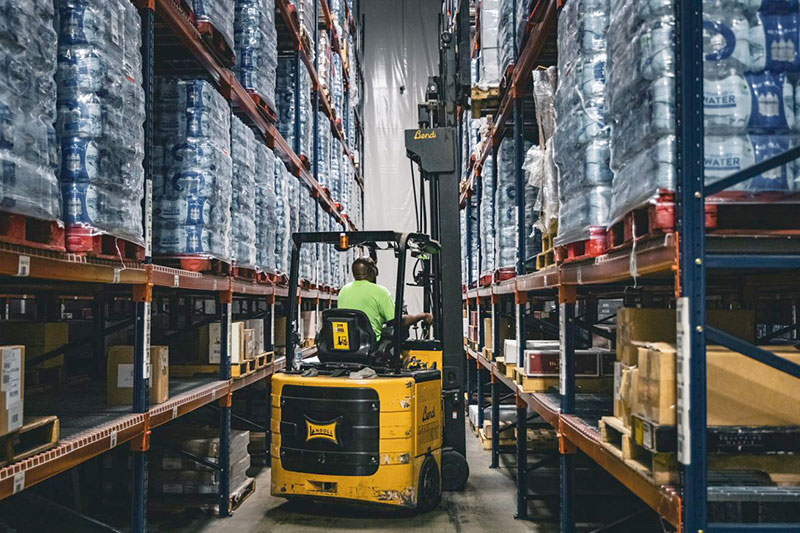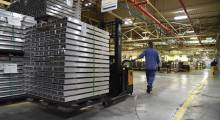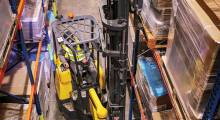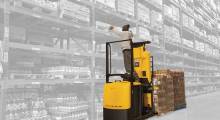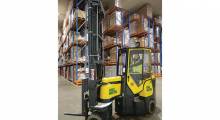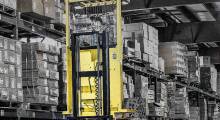On the surface, narrow aisle (NA) and very narrow aisle (VNA) trucks appear to be specialty solutions for inventory management and order fulfillment. In reality, they’re closer to a Swiss army knife, able to address a range of new and evolving challenges in warehousing and distribution today. Here’s why.
While the specifics of the two differ, the core of their versatility is common. NA trucks typically operate in 9- to 10-foot-wide aisles while VNA trucks fit into 6-foot or even more narrow aisles. For comparison, standard warehouse aisle width is generally pegged at 12 feet.
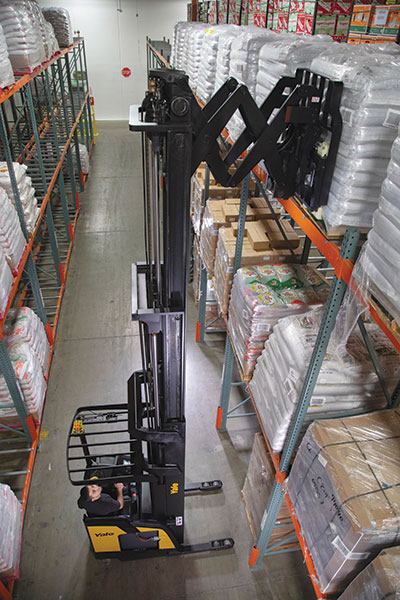
Quite simply, who wouldn’t take at least a second look at a chance to reduce a facility footprint by 25% or even 50%, asks Al Connelly, sales manager at Landoll. By the way, the company specializes in VNA and even more narrow aisle trucks.
What Connelly has seen over the past decade is a shift in companies interested in VNA trucks.
“Our customer base used to be confined to a great extent to facilities of 50,000 square feet or so. Now, we’re seeing much more action in facilities of 200,000 square feet and larger,” Connelly says. In addition, Fortune 500 companies have become more interested during that time.
At the same time, a bit of an opposite trend is underway. “In e-commerce in particular, the trend is to smaller DCs built closer to the customer for more instant delivery gratification,” explains Mike Gay, director of warehouse product planning and solutions at Yale Lift Truck Technologies.
In fact, we’ve probably all heard Andy Jassy, president and CEO of Amazon, talk recently about what his company has done to move to smaller DCs closer to the customer. This is clearly not a trend to underestimate.
As Shannon Curtis, product manager for Class 2 trucks at Raymond, explains, the product mix in all DCs is churning more than ever as the number of SKUs continues to climb. That has put pressure to get more storage locations and pick faces into those smaller facilities. Narrower aisles give you more potential rack faces and more access to stored goods with less travel time in between picks.
In addition, slotting has become more dynamic, Curtis says. That often results in new configurations that require maximum flexibility by trucks and drivers to access inventory in less time. In short, all of this variability creates an environment that requires trucks and operators to have maximum flexibility. And they do.
“Meanwhile, facility designers have moved the clear-height sweet spot up 10 feet from 35 to 45 feet in an effort to make footprints more compact. And, in turn, that has put even more emphasis on NA and VNA layouts,” Gay continues. It’s also changed what the trucks need to do.
“This is a story of lowering costs, increasing productivity and maximizing footprint efficiency,” explains Curtis. “Ultimately, the drive is to use narrow aisles to increase storage density and create more flexibility in the facility,” she adds.
And increasingly, NA and VNA trucks are being upgraded to meet not just these challenges but others that facilitate process improvements.
Integrating NA and VNA trucks
Let’s get one key point front and center here. For all that they can do, NA and VNA trucks do not come cheap in terms of upfront cost.
Standard, man-down NA trucks can be as much as twice the cost of a standard counterbalanced truck. Meanwhile, the most advanced turret trucks and orderpickers can be priced even double those numbers.
Those upfront costs, however, are not a deterrent apparently. “Raymond is seeing a strong adoption rate of its latest high-capacity orderpicker, indicating that users are excited about this technology and see real benefits,” says Curtis.
Michael Brunnet, warehouse and systems trucks sales manager at Junghenrich, says the most automated of NA and VNA trucks have a two-year return on investment. Some of that rapid payback is due to the inherent value proposition of narrower aisles. Key points here are increased storage density (more locations per footprint square foot) and throughput improvements possible with the increased rate of movement of guided NA and VNA trucks.
In some cases, wire guidance (which dominates) and rail guidance (about 5%) actually take over control of the truck from the operator for certain movements and activities. All the while the truck follows directions from a warehouse management system (WMS).
As Brunnet points out, the guidance systems free up the operator to focus on vehicle speed rather than steering, allowing faster movement through the aisles.
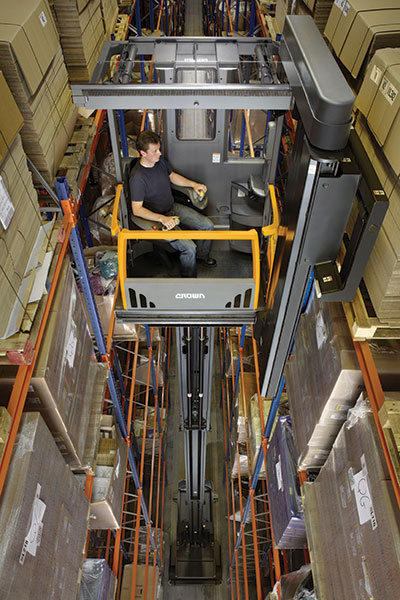
Meanwhile, the WMS tells the truck one order at a time where to go and what do once there. In a typical narrow aisle operation, the WMS provides control about half of the time, says Brunnet.
Quite simply, the story here is about much more than just the truck itself.
In fact, introducing NA and VNA trucks to a facility is actually closer to a system decision and requires a system mindset, explains Jim Gaskell, director of global automation and emerging technologies at Crown. And with good reason.
While many NA and VNA trucks are man-down models, many others, such as certain orderpickers and turret trucks, are man-up and have operator assist features at a minimum.
“While not typically as automated as an automated storage and retrieval system, these trucks operate in a highly prescriptive manner. And that is quite a different operating condition than manually driven lift trucks,” says Gaskell. “As a result, how a facility’s full fleet of manual, operator assist and even more automated trucks interact needs to be thought through up front,” adds Gaskell.
Key safety features
To help with this Rubik’s Cube of factors, suppliers have introduced several safety systems to protect people, trucks and productivity.
For instance, Gay talks about Yale Reliant. This package of detection technologies helps operators detect obstacles with performance triggers that slow down the truck automatically. At the same time, the system supports truck stability by monitoring both truck and load status.
Crown offers a proximity detection system (PDS) for both in-aisle and outside aisle safety, explains Gaskell. When an obstacle is detected, the system slows movement to 1 mph.
Raymond’s take on this is called an in-aisle detection system that notifies the operator of objects in the truck’s path then decelerates to a full stop. The operator can then continue operation of the truck but speed is limited to 1 mph.
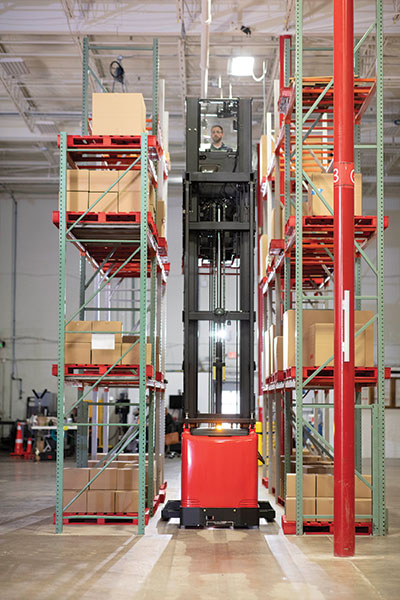
Operator trust
As Raymond’s Curtis points out, the NA and VNA truck workforce requires more skill than those on conventional counterbalanced trucks. The onboard technology itself is more sophisticated, and the work environment, especially 40 or more feet up in a very narrow aisle, is more demanding.
“Operators are required to position trucks and access storage locations at height with minimal room for error,” adds Curtis. As a result, explains that it’s more difficult to find and retain operators.
There’s also the matter of making operators feel safe and secure at heights. Some of that trust is built with proper training. In addition, the design of the truck as well as personal safety systems are also important, too.
As suppliers will say, some of that sense of trust is in the design of the truck. Work platforms are designed to give the operator a sense of stability. Positioning of control handles helps. Other ergonomic features contribute to an operator’s sense of security.
Equipment such as an integrated tether system secures operators, giving them sufficient latitude to move safely and without hesitation especially in the order fulfillment process.
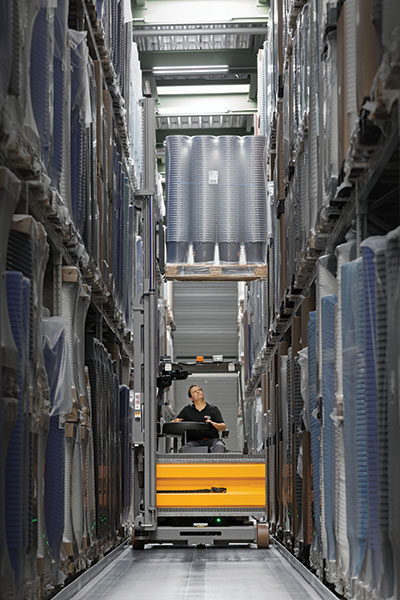
The latest models
As you probably already imagine, with all those process and system demands, suppliers are actively introducing new models.
Earlier this year at ProMat, Connelly says Landoll introduced two new articulating Bendi trucks. These 3,000-pound and 4,000-pound capacity NA trucks provide front-loader capabilities. The articulated 42-inch front axle allows the trucks to operate in the narrowest of aisles using high-visibility, three- and four-stage masts.
The latest entries from Jungheinrich are a man-down turret truck and a sit/stand pantograph reach truck, says Brunnet. The former features unobstructed visibility of the forks, speeding delivery and retrieval of loads. The pantograph truck has lifting speeds of 165 feet per minute, said to be one of the fastest available.
The most recent entry from Yale, says Gay, is an NA reach truck with a focus on operator comfort and security. An operator sensing system with optical sensors, not pedals, detects operator presence. It allows the operator to move freely in the compartment and more comfortably adjust stance. Up to 60% of shocks and vibrations are absorbed by a suspended floor system, minimizing operator fatigue.
A high-capacity orderpicker from Raymond reaches to 456 inches, one storage level higher than the 390-inch reach of previous models, says Curtis. It plays directly into the trend to going higher in warehouses to reduce footprint as much as possible.
While expensive, NA and VNA trucks are delivering increased versatility and speed while protecting operators in the daily push to fill orders faster and more efficiently.
Article topics
